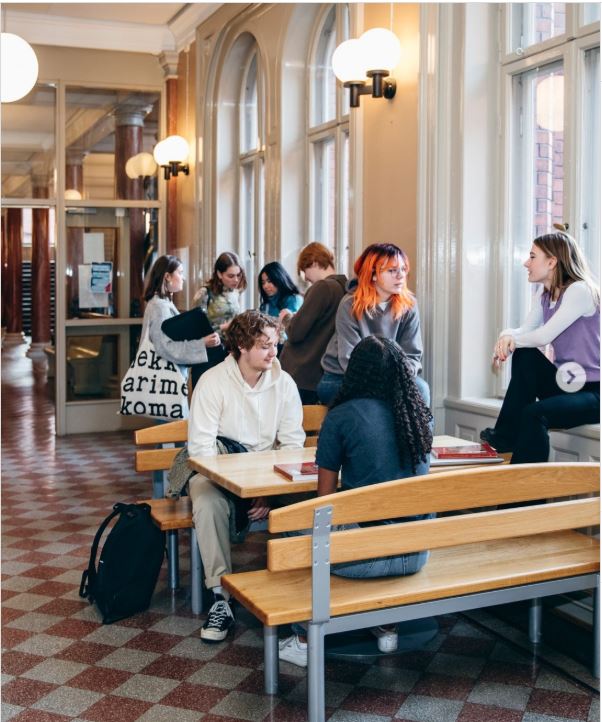The Swedish school system
Education is key in Sweden. It is tax-financed, and compulsory from the age of 6.
In the Swedish school system, children go to school for at least ten years from the year they turn six, as mandated by the Swedish Education Act (link in Swedish). Sweden's long focus on education is quoted as one of the explanations for the country's capacity for innovation.
Nursery school
Förskola (nursery school, or preschool) is provided by Swedish municipalities for children ages one to five. The amount of municipal subsidy for preschool depends on the child’s age and whether the parents work, study, are unemployed or on parental leave for other children.
Swedish preschool emphasises the importance of play in a child’s development, with a curriculum aiming to ensure children’s individual needs and interests. Gender-aware education is increasingly common, striving to provide children with the same opportunities in life regardless of gender.
Compulsory schooling
Swedish compulsory schooling consists of four stages: förskoleklass (‘preschool year’ or year 0), lågstadiet (years 1–3), mellanstadiet (years 4–6) and högstadiet (years 7–9). Children between ages six and thirteen are also offered out-of-school care before and after school hours.
Compulsory education also includes sameskolor (Sami schools) for children of the indigenous Sami people.
Upper secondary school
Gymnasium (upper secondary school, sixth form or high school, years 10–12) is optional. There are eighteen regular national programmes of three years to choose from, six of which are preparatory for higher education such as university, and twelve of which are vocational.
While entrance requirements vary between programmes, all of them demand students to have passing grades in Swedish/Swedish as a second language, English and mathematics from their final year of compulsory schooling.
In 2024 (latest statistics), 84.1 cent of Swedish ninth-year students qualified for either a higher education preparatory programme or a vocational programme.
That same year, 72.4 per cent of students finishing their upper secondary school education finished with basic eligibility for university studies.
Introductory programmes
For those whose grades don’t qualify for upper secondary school, there are four so-called introductory programmes to choose from. These programmes are individually taileored and aim to help students either move on to a national programme or find a job.
Independent schools
The Swedish school system includes a growing number of independent schools with public funding, friskola in Swedish. Following a law change in the 1990s, parents and their children can choose among tuition-free schools that are either municipal or private.
Although privately-run schools have been in existence for as long as there has been compulsory education in Sweden, they were not a wide-spread competitive alternative to municipal schools until the 1992 law provided them with public funding.
These publicly funded non-municipal schools are called friskola to differentiate them from tuition-based private schools (of which there are only a handful left in Sweden).
In Sweden, independent schools must be approved by the Schools Inspectorate and follow the national curricula and syllabuses, just like regular municipal schools.
Today, around one in five of all Sweden's compulsory schools are independent schools. Around one in three of all Sweden's upper secondary schools are independent schools.
Children’s rights
The Swedish Education Act, along with the Swedish Discrimination Act, strives to protect children and students from discrimination and degrading treatment. In essence, the headteacher of nursery schools, schools and adult education programmes are responsible for enforcing prohibitions against discrimination and degrading behaviour, and for promoting equal treatment. The Equality Ombudsman supervises compliance with this law.
All students have access to a school doctor, school nurse, psychologist and school welfare officer – all tax-funded.
Also, since 2020, the United Nations Convention on the Rights of the Child is Swedish law.
Recent reforms in the Swedish school system
In 2011, the Swedish Education Act was thoroughly revised, with higher formal requirements for teachers than earlier. The current act also puts more focus on student and teacher health, and allows more freedom of choice than previously.
That same year, Sweden's national curriculum came into force. The curriculum, which applies to all forms of compulsory education in the Swedish school system, came with new general goals, guidelines and syllabuses. Mandatory national subject tests to assess student progress – which were already in place for years 3 and 9 – were added for year 6.
Grading system
The grading in the Swedish school system was also updated in 2011, to a scale with six grades from A to F, where A to E are passing grades, and F represents a failing grade. This system is similar to the European Credit Transfer and Accumulation System (ECTS), the standard grading system for higher education in Europe.
Since 2012, grades are assigned from year 6 in Sweden.
Teacher certification
As of 1 December 2013, professional certification is required for school and pre-school teachers on permanent contracts. The decision aimed to raise the status of the teaching profession, support professional development and thus increase quality in education.
Government authorities within education
The Ministry of Education and Research is responsible for the government’s education and research policies. The ministry works on issues including school performance, conditions for teachers and study financing.
The Swedish Schools Inspectorate (Skolinspektionen) oversees and examines the quality of schools across the country through regular inspections. The inspectorate monitors compliance with the Education Act.
The National Agency for Education (Skolverket) provides information about education, promotes understanding, and administers public funding and grants.
The National Agency for Special Needs Education and Schools (Specialpedagogiska skolmyndigheten) provides children, young people and adults with disabilities with the same opportunities for development and education that everyone in society is entitled to.
The Swedish National Agency for Higher Vocational Education (Myndigheten för yrkeshögskolan) analyses labour market demands for workforce education, decides what programmes are to be included in higher vocational education and allocates public funding to education providers. The agency also assesses and inspects the quality and results of this education.
The Sami School Board (Sameskolstyrelsen, link in Swedish) is an administrative agency for public Sami schools and their affiliated activities, which are governed by the Sami School Ordinance.


